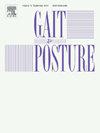一个僵硬的极简鞋垫的意想不到的影响对前足和踝关节的生物力学在行走
IF 2.4
3区 医学
Q3 NEUROSCIENCES
引用次数: 0
摘要
本研究的目的是探讨极简硬鞋垫在限制/减少第一跖趾关节(1MTP)活动范围方面的功效,并探讨步行时对踝关节的影响。据推测,极简硬鞋垫会显著降低1MTP的运动学和动力学参数,同时在踝关节处产生代偿效应。方法招募14名健康受试者。三维下肢和前足运动学测量在步行时,以自己选择的速度与刚性和控制鞋垫。采用离散点统计分析和统计参数映射(SPM)来评估鞋垫条件对运动学和动力学参数的主要影响。结果在步行的第三摇臂阶段,不同鞋垫条件之间存在显著差异,硬鞋垫出人意料地增加了运动范围(p <; 0.001),降低了MTP背屈角速度,增加了MTP跖屈角速度(p <; 0.001),增加了外MTP背屈力矩和发电量(p <; 0.001)。在踝关节处,硬鞋垫增加了踝关节背屈角速度(p <; 0.001),降低了踝关节跖屈角速度(p <; 0.001),降低了踝关节吸能(p <; 0.001)和发电量(p <; 0.001)。结论/临床相关性临床医生和研究人员应谨慎对待预期的机械效应和硬鞋垫的实际生物力学影响,并牢记作用于一个关节会产生近端代偿。本文章由计算机程序翻译,如有差异,请以英文原文为准。
The unexpected influence of a stiff minimalist insole on the forefoot and ankle joint biomechanics during walking
The aim of this study was to explore the efficacy of a minimalist stiff insole in limiting/reducing first metatarsophalangeal joint (1MTP) range of motion and to explore the impact on the ankle joint during walking. It was hypothesized that the minimalist stiff insole would significantly reduce 1MTP kinematic and kinetic parameters whilst causing compensatory effects at the ankle joint.
Methods
Fourteen healthy participants were recruited. Three-dimensional lower limb and forefoot kinematics were measured during walking at a self-selected speed with a stiff and control insole. Discrete point statistical analysis and statistical parametric mapping (SPM) were used to evaluate the main effects of the insole conditions on kinematic and kinetic parameters.
Results
Significant differences were seen between insole conditions during the 3rd rocker phase during walking with the stiff insole surprisingly increasing the range of motion (p < 0.001), reducing MTP dorsiflexion angular velocity and increasing MTP plantarflexion angular velocity (p < 0.001), and increasing external MTP dorsiflexion moment and power generation (p < 0.001). At the ankle, the stiff insole increased ankle dorsiflexion angular velocity (p < 0.001), decreased ankle plantarflexion angular velocity (p < 0.001), and decreased ankle power absorption (p < 0.001) and power generation (p < 0.001).
Conclusion/clinical relevance
Clinicians and researchers should be cautious about the expected mechanical effects and the actual biomechanical impact of stiff insoles and keep in mind that acting on one joint can create proximal compensations.
求助全文
通过发布文献求助,成功后即可免费获取论文全文。
去求助
来源期刊

Gait & posture
医学-神经科学
CiteScore
4.70
自引率
12.50%
发文量
616
审稿时长
6 months
期刊介绍:
Gait & Posture is a vehicle for the publication of up-to-date basic and clinical research on all aspects of locomotion and balance.
The topics covered include: Techniques for the measurement of gait and posture, and the standardization of results presentation; Studies of normal and pathological gait; Treatment of gait and postural abnormalities; Biomechanical and theoretical approaches to gait and posture; Mathematical models of joint and muscle mechanics; Neurological and musculoskeletal function in gait and posture; The evolution of upright posture and bipedal locomotion; Adaptations of carrying loads, walking on uneven surfaces, climbing stairs etc; spinal biomechanics only if they are directly related to gait and/or posture and are of general interest to our readers; The effect of aging and development on gait and posture; Psychological and cultural aspects of gait; Patient education.
 求助内容:
求助内容: 应助结果提醒方式:
应助结果提醒方式:


